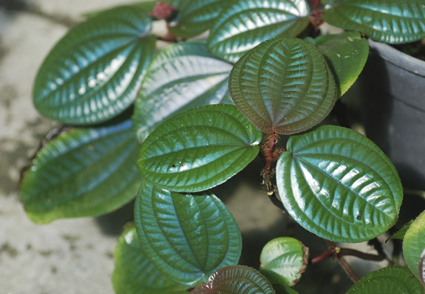Abstract
A new genus, Nephoanthus, is established based on morphological and molecular data. It comprises two species distributed in montane forests of central to southern Vietnam and Hainan Island: the type species N. prostratus and a new species N. nubigenus. Nephoanthus is morphologically similar to Phyllagathis but phylogenetically remote from the type species of Phyllagathis in the analyses of both plastid genome and nrITS sequences. Nephoanthus is genetically associated to but significantly morphologically distinct from Driessenia, Heteroblemma, Medinilla and Tigridiopalma. A detailed morphological comparison of Nephoanthus and related taxa is provided.
References
Cámara-Leret, R., Ridder-Numan, J.W.A. & Veldkamp, J.F. (2013) Revision of Heteroblemma gen. nov. (Dissochaeteae–Melastomataceae) from Malesia and Vietnam. Blumea 58: 229–240. https://doi.org/10.3767/000651913X674945
Cellinese, N. (2002) Revision of the genus Phyllagathis Blume (Melastomataceae: Sonerileae) I. The species of Burma, Thailand, Peninsular Malaysia and Sumatra. Blumea 47: 463–492.
Cellinese, N. (2003) Revision of the genus Phyllagathis (Melastomataceae: Sonerileae) II. The species in Borneo and Natuna Island. Blumea 48 (1): 69–97. https://doi.org/10.3767/000651903X686060
Chen, C. (1979) A new genus Tigridiopalma C. Chen of Melastomataceae. Acta Botanica Yunnanica 1: 106–108.
Chen, C. & Renner, S. (2007) Melastomataceae. In: Wu, Z.Y., Raven, P.H. & Hong, D.Y. (Eds.) Flora of China 13: 360–399. Science Press, Beijing, and Missouri Botanical Garden Press, Missouri.
Gaudichaud, C. (1830) Botanique, part 12. In: Freycinet, H.L.C. de (Ed.) Voyage autour du monde: entrepris par ordre du roi […] execute sur les corvettes de S. M. l’Uranie et la Physiciene. Pilet-Ainé, Paris, pp. 465– 522, pls. 111–120.
Hansen, C. (1990) New species and combinations in Allomorphia, Phyllagathis and Sporoxeia (Melastomataceae) in Indo-China. Bulletin du Muséum National d’Histoire Naturelle, Section B, Adansonia, 4e série 12 (1): 37–41.
Jack, W. (1823) On the Malayan species of Melastoma. Transactions of the Linnean Society of London 14: 11. https://doi.org/10.1111/j.1095-8339.1823.tb00077.x
Korthals, P.W. (1842–1844) Bijdrage tot de kennis der Indische Melastomaceae. In: Temminck, C.J. (Ed.) Verhandelingen over De natuurlijke geschiedenis der Nederlandsche overzeesche bezittingen, Botanie. Natuurkundige Commissie, Leiden, pp. 236–243.
Lin, C.W., Chen, C.F., and Yang, T.Y.A. (2017) Ten new species of Phyllagathis (Trib. Sonerileae, Melastomataceae) from Sarawak, Borneo. Phytotaxa 302 (3): 201–228. https://doi.org/10.11646/phytotaxa.302.3.1
Liu, Y., Veranso-Libalah, M.C., Kadereit, G., Zhou, R.C., Quakenbush, J.P., Lin, C.W. & Wai, J.S. (in press) Systematics of the tribe Sonerileae. In: Goldenberg, R., Michelangeli, F.A. & Almeda, F. (Eds.) Systematics, Evolution, and Ecology of Melastomataceae. Springer.
Zeng, S.J., Xu, Y.C., Wang, G.T., Jia, P. & Cui, D.F. (2021) Tigridiopalma exaltata, a new and endangered species of Melastomataceae in China. Phytokeys 176: 33–42. https://doi.org/10.3897/phytokeys.176.63619
Zhou, Q.J., Lin, C.W., Dai, J.H., Zhou, R.C. & Liu, Y. (2019a) Exploring the generic delimitation of Phyllagathis and Bredia (Melastomataceae): A combined nuclear and chloroplast DNA analysis. Journal of Systematics and Evolution 57 (3): 256–267. https://doi.org/10.1111/jse.12451
Zhou, Q.J., Dai, J.H., Lin, C.W., Denda, T., Zhou, R.C. & Liu, Y. (2019b) Recircumscription of Bredia and resurrection of Tashiroea (Sonerileae, Melastomataceae) with description of a new species T. villosa. Phytokeys 127: 121–150. https://doi.org/10.3897/phytokeys.127.36608
Zhou, Q., Lin, C.W., Ng, W.L., Dai, J., Denda, T., Zhou, R. & Liu, Y. (2019c) Analyses of plastome sequences improve phylogenetic resolution and provide new insight into the evolutionary history of Asian Sonerileae/Dissochaeteae. Frontiers in Plant Science 10: 1477. https://doi.org/10.3389/fpls.2019.01477


